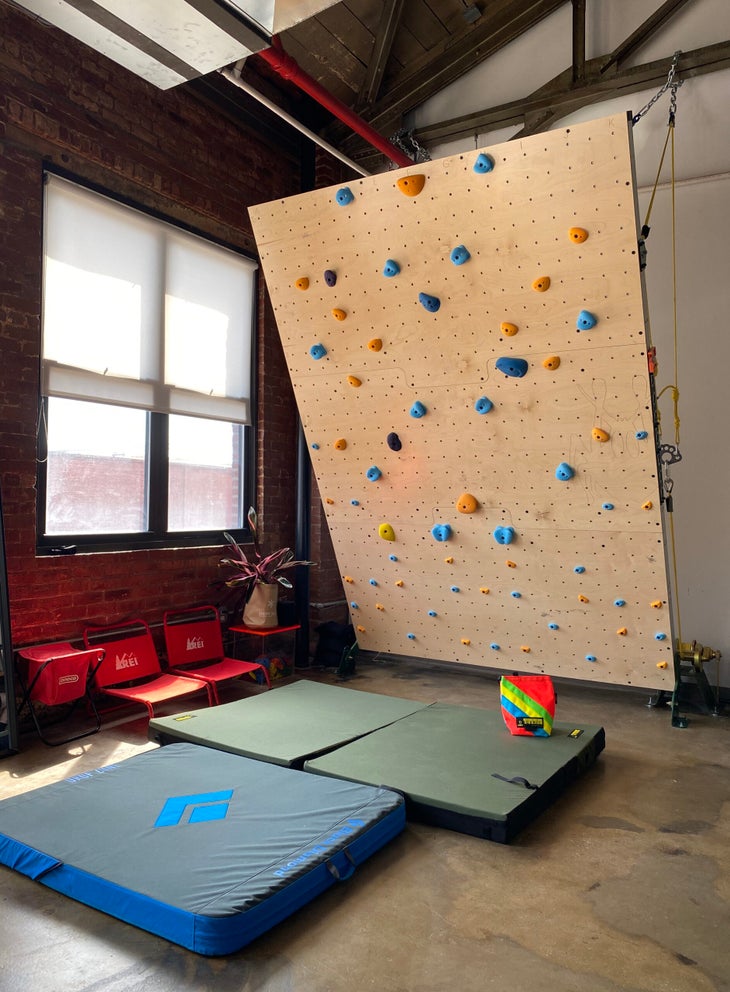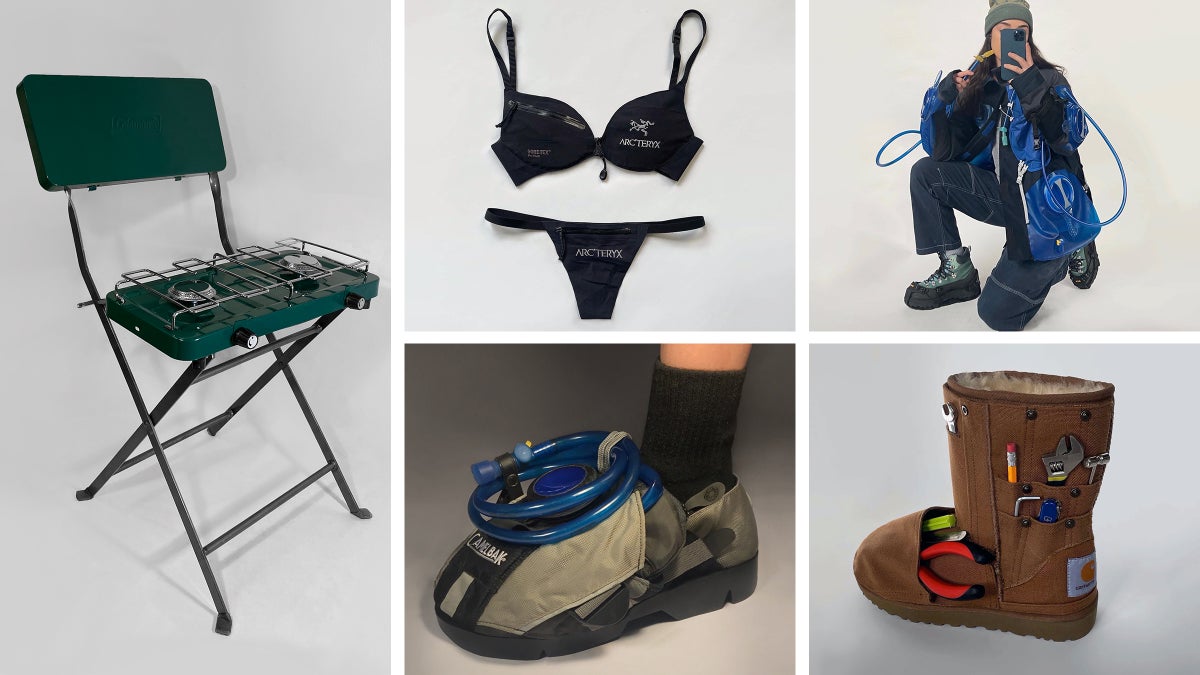No products in the cart.
Outdoor Adventure
This Carhartt Bikini Will Change How You Think About Upcycling
Get full access to Outside Learn, our online education hub featuring in-depth fitness, nutrition, and adventure courses and more than 2,000 instructional videos when you
sign up for Outside+.
If you’ve spent time on social media the past couple of years, it’s likely you’ve come across Nicole McLaughlin’s viral designs. The 28-year-old crafts her pieces with upcycled clothing and gear from recognizable outdoor brands and household items: she’s transformed Carhartt beanies into shorts, Patagonia fleeces into a beach set, an Arc’teryx jacket into a bikini, and reused CamelBak water reservoirs to make a jacket and bucket hat, among a long list of other really cool shit—like this pickle jar shoe.
While her pieces are often functional (the CamelBak jacket held water), they aren’t meant for use in the real world; she says the goal is to get people to see just how reusable existing materials can be and start a conversation around sustainability. After she photographs each one-off piece for the ‘gram, she deconstructs it so the materials can be used in future projects. McLaughlin has used the same volleyball material in a shoe, chair cushioning, a glove, and a handbag commissioned for Gucci. “It’s lived so many lives,” she says, and it’s currently in her materials library, waiting to live yet another life. “I’m always trying to use everything I have, every scrap of every project.”
McLaughlin’s work stands out because she knows how to create visual impact, a skill she honed while working at Reebok, first as an intern, then a full-time graphic designer. “That’s kind of where everything started to kick off in terms of my personal work,” she recalls of her time creating footwear and apparel graphics. “I think I had that childhood sense of wonder where I wanted to just work with my hands and create something tangible.” She began sifting through boxes of old merchandise and started to take things apart and put them back together in different ways. She immediately recognized she’d hit a vein. “This is something so special,” she remembers thinking. “There was just so much more life left to these products.”
She made the transition to being a full-time freelance creative in 2019, and she’s since amassed nearly 800,000 followers on Instagram and collaborated with the world’s biggest outdoor and fashion brands including Arc’teryx, Rumpl, and Hermès. With profiles in Vogue and GQ, the fashion audience has always been drawn to her work, “but my intention was always very much rooted in sport. I think the visual language is so strong,” she says. “I love outdoor gear. It’s the utility aspect. There’s so much going on with a lot of the pieces, and for me, it’s a bit nostalgic.”
Outdoor sport has always been a big part of her life, but in recent years, climbing has become a big passion of McLaughlin’s, as evident in many of her designs. She began to hit up the climbing gym during her Rebook days in Boston and has since transitioned to outdoor climbing and bouldering. In May, she moved to Boulder, Colorado for easy access to the outdoors, but will still keep her Brooklyn design studio. Other than her personal work, climbing is about the only other thing you’ll find posted on her social media. “I think I gravitated towards it [because] it’s a very problem-solving type of experience where you’re plotting your next moves, and you really have to work things out.” She even has a built-in rock climbing wall in the studio. “It’s a nice mental reset during the day. Sometimes I’ll get on and do a couple of climbs or do some pull-ups, and it feels good to get my brain moving.”
Like many artists, she finds inspiration everywhere; walking the streets of New York, perusing thrift shops, and through outdoor activities. At a recent community cleanup, a found piece of trashed packaging inspired a new project. “It’s right there in front of us. It’s turning that part of your brain on to be able to recognize it.”

Because her pieces are rooted in the notion of potential, there’s an apparent optimism to her work, but there’s a satirical element, too. She plays off brand reputation by putting logos front and center and incorporates universally recognized items like Jansport backpacks and The North Face puffy jackets as a playful, yet pointed, nod to capitalist consumption. “If it didn’t have the brand logo, it probably wouldn’t get as much attention. For better or for worse, our consumerism habits really do come out.” You can’t help but chuckle at a thong made from Dickies workwear that actually holds tools. “I find the humor in all of this and I think that’s what gets people involved,” says McLaughlin. “It’s a way to connect people and talk about sustainability in a more approachable way. Hopefully, they’ll come for the designs and stay for the conversation around upcycling.”
One of her most important partnerships to date is with Arc’teryx, as their first design ambassador. “Arc’teryx has been a great support for me when it comes to material, [and] it’s really been an opportunity to help with education,” she says. McLaughlin leads workshops teaching people how to make upcycled products of their own through the partnership, and she credits the brand for facilitating a place for connection. “Connecting people, connecting the outdoors to it, is important. The more people get outside, the more they want to protect the world and the nature around them.”

On choosing what outdoor brands she partners with, “it’s all about a connection that I have,” says McLaughlin. “It is very interesting for me to take on a project where I see potential within sustainability and upcycling.” Many of her closest partnerships involve brands actively achieving their sustainability goals, but she won’t turn away a company if she sees an opportunity to move the needle. “It makes me want to push to figure out we could be doing better, and trying to implement a circular model into a company has been a huge goal of mine.” She wants brands to see the potential of the materials they already have lying around and help them create blueprints they can work with.
She hopes her work inspires others to see the value in the things they do have and to give upcycling a shot. “There’s something about taking a secondhand piece of clothing, an item from a thrift store, or something from your closet that you’re ready to throw away or donate, and use that to try to make something,” she concludes. “[The] possibilities are endless.”

